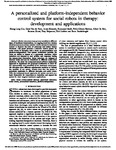A personalized and platform-independent behavior control system for social robots in therapy: Development and applications
| dc.contributor.author | Cao, HL | en |
| dc.contributor.author | Van De Perre, G | en |
| dc.contributor.author | Kennedy, J | en |
| dc.contributor.author | Senft, E | en |
| dc.contributor.author | Esteban, PG | en |
| dc.contributor.author | De Beir, A | en |
| dc.contributor.author | Simut, R | en |
| dc.contributor.author | Belpaeme, T | en |
| dc.contributor.author | Lefeber, D | en |
| dc.contributor.author | Vanderborght, B | en |
| dc.date.accessioned | 2018-09-10T10:52:30Z | |
| dc.date.available | 2018-09-10T10:52:30Z | |
| dc.date.issued | 2019-09-01 | en |
| dc.identifier.issn | 0278-0062 | en |
| dc.identifier.uri | http://hdl.handle.net/10026.1/12302 | |
| dc.description.abstract |
Social robots have been proven beneficial in different types of healthcare interventions. An ongoing trend is to develop (semi-)autonomous socially assistive robotic systems in healthcare context to improve the level of autonomy and reduce human workload. This paper presents a behavior control system for social robots in therapies with a focus on personalization and platform-independence. This system architecture provides the robot an ability to behave as a personable character, which behaviors are adapted to user profiles and responses during the human-robot interaction. Robot behaviors are designed at abstract levels and can be transferred to different social robot platforms. We adopt the component-based software engineering approach to implement our proposed architecture to allow for the replaceability and reusability of the developed components. We introduce three different experimental scenarios to validate the usability of our system. Results show that the system is potentially applicable to different therapies and social robots. With the component-based approach, the system can serve as a basic framework for researchers to customize and expand the system for their targeted healthcare applications. | en |
| dc.format.extent | 334 - 346 | en |
| dc.language.iso | en | en |
| dc.title | A personalized and platform-independent behavior control system for social robots in therapy: Development and applications | en |
| dc.type | Journal Article | |
| plymouth.issue | 3 | en |
| plymouth.volume | 11 | en |
| plymouth.publication-status | Published | en |
| plymouth.journal | IEEE Transactions on Medical Imaging | en |
| dc.identifier.doi | 10.1109/TCDS.2018.2795343 | en |
| plymouth.organisational-group | /Plymouth | |
| plymouth.organisational-group | /Plymouth/Faculty of Science and Engineering | |
| plymouth.organisational-group | /Plymouth/Research Groups | |
| plymouth.organisational-group | /Plymouth/Research Groups/Marine Institute | |
| plymouth.organisational-group | /Plymouth/Users by role | |
| dc.identifier.eissn | 1558-254X | en |
| dc.rights.embargoperiod | Not known | en |
| rioxxterms.versionofrecord | 10.1109/TCDS.2018.2795343 | en |
| rioxxterms.licenseref.uri | http://www.rioxx.net/licenses/all-rights-reserved | en |
| rioxxterms.type | Journal Article/Review | en |


